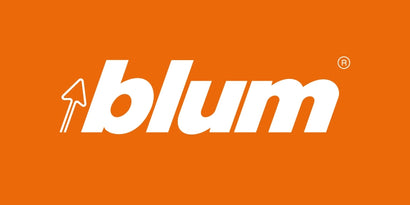
WHICH HINGE?
WHICH HINGE?
Are hinges something you take for granted? Or just simply something too confusing?
Looking in the BLUM catalogue you can see how many hinges we currently produce. There are around 127 pages devoted to hinges because we try to offer solutions to everyone’s individual needs. I am hopefully going to try and de-mystify some of this and give you the chance to find the perfect hinge.
So, there are two main types of hinges based of the installation method, the MODUL and the CLIP top ranges. Our CLIP top range is broken down between CLIP top and CLIP top BLUMOTION.
The simple difference between the two is that CLIP top ranges clip on and off tool-free, whereas MODUL is a screw-on hinge.
I want to concentrate on the CLIP hinges here, they are the newest and most comprehensive range.
The first question to ask yourself is “how much do you or your customers want the door to open by?” This is usually the best way to narrow down the exact hinge, but not always, as we will see.
The next question would then be “how is my door sitting on the carcass” and this falls into three different variants, overlay/lay-on, inset or sometimes half overlay.

By answering those two questions you should be able to select your hinge if it is a simple application. The only choices then would be soft close or not, and ways of fixing the hinges to the door.
“What Next”
Questions then arise when we fall outside of the common 19mm thick overlay door, as when we push design, other factors start to come into play. So, for example, where you want to install a thick door, anywhere between 19mm and 39mm you may need to think a little differently. Although the 110° hinge will work up to 26mm at a push, it may leave unsightly gaps, whereas a 95° thick door/profile hinge would allow much more adjustment at a very slight compromise in throw. However, if 95° is seen as too little throw, then we can suggest the 125° hinge. As you can see, there are various options and always a solution.

I mentioned earlier the different ways doors sit on, or in, the carcass. The majority of what we see in modular furniture tends to be overlay, but we are seeing a lot more of bespoke cabinetry now using inset hinges. In these cases, the BLUM concealed hinge offers a lot of advantages over the traditional butt hinge, as it allows a lot of adjustment, ensuring a consistent gap. One hinge that is not talked about much is the half-overlay hinge, and yet is one that could potentially be a useful solution to a lot of cabinet makers. Imagine for a second, a kitchen cupboard next to a front-loading washing machine, and the customer has asked, at the last moment, could you put a door in front of the washing machine? So rather than trying to squeeze another carcass around the appliance, you can simply reduce the width of the adjoining door and use the same carcass wall to support hinges for both sides. In fact, anywhere you have to share the same carcass, the half overlay hinge is the perfect solution.
We are always asked the question “How big and how heavy can I go?” and unfortunately there is a limit. BLUM hinges are designed to work in a normal internal setting and have been extensively tested to work for a lifetime within these limits. We recommend doors to be no larger than 600mm wide and 2500mm high with a maximum weight of 22Kg. But, if you do want to go larger, there is another option! Look into the AVENTOS range as a possible way of finding a solution.
“Push even further”
So, this then takes us to what we consider hinges that fall outside of the normal. For example, hinges for mirror and glass doors, corner hinges and even angled hinges.
Again, the same questions you need to ask yourselves apply, however, the applications where these hinges are used are fairly specific and it is a little simpler to determine what is best for your given application.
Angled applications will always be more difficult and knowing the actual angle is crucial to getting the right hinge. For this, we would recommend using our simple protractor, which will help determine the correct hinge and this can then be cross-referenced with the catalogue.
I hope this has given a little insight into choosing the right hinge, however, rest assured we are always a call or LIVE SUPPORT away for any questions you may have. If you ever need any advice, we will happily suggest hinges for your given application.
Written by Peter Sharratt - Blum Technical Team




Matthew Glanfield
Author